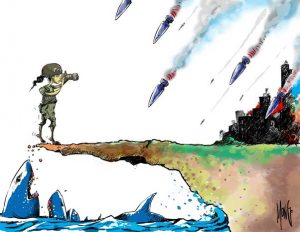
Credit: Ramón Díaz Yanes – Cartoon Movement’. The image was originally featured in The New Humanitarian | Why so many humanitarian crises are ‘forgotten’, and 5 ideas to change that
By Martin Scott, Kate Wright and Mel Bunce
NORWICH / EDINBURGH / LONDON, Feb 1 2023 – In a new book, entitled Humanitarian Journalists: Covering Crises from a Boundary Zone, we document the unique reporting practices of a small but influential group of journalists who defy conventional approaches to covering humanitarian crises.
We argue that these humanitarian journalists show us that another kind of crises reporting is possible.
But who exactly are humanitarian journalists? What motivates them? Who do they work for? And how is their coverage of humanitarian affairs different to mainstream journalism?
In this article, we answer these questions though an account of ‘Sophia’ a fictional journalist whose story helps illustrate the key themes of our research.
Sophia: A humanitarian journalist
Sophia is a humanitarian journalist. She works for a small non-profit news outlet that covers international aid and global affairs. She regularly reports on under-reported crises, with a focus on in-depth, explanatory, and solutions-oriented journalism.
She is particularly keen to highlight the perspective, not only of affected citizens, but of a range of other local actors including rebels, aid workers, politicians, and think-tanks. She has significant freedom to choose which stories to cover and how to report them and regularly commissions local stringers living in affected countries.
Sophia used to work for a large international news broadcaster. Despite having a permanent position and a significantly higher salary, she left after just eighteen months because she was frustrated by what she felt was their rigid and formulaic approach to covering global affairs. She thought that much of their coverage of recent humanitarian crises was superficial and fleeting.
Although she was proud that she helped break a news story revealing corruption within an international NGO, she worries that it unfairly damaged the reputation of the humanitarian sector as a whole, because some of the subtleties of international humanitarian response got lost in the reporting.
The news organisation Sophia works for now generates very little advertising or reader revenue and relies almost exclusively on short term grant funding from a very small number of private foundations. Although she has never felt under any pressure to cover stories in ways that might please their current, or potential donors, she does resent the amount of time it takes to meet their reporting requirements.
If their funding is cut, and she loses her job, she intends to work either as a freelance journalist, or as an aid agency press officer. The only other news outlet she is aware of that covers similar stories has recently closed due to a lack of funding.
Sophia has never actually met any of her current colleagues in person as they all work remotely, in different countries. During their daily online editorial meetings they frequently disagree about which stories fall within their remit.
There is no consensus about what makes a story ‘humanitarian’, as opposed to a human rights or global development issue, for example. For this reason, some of the stories she pitches still get rejected – and she doesn’t fully understand why.
Although Sophia was recently nominated for a One World Media award, in general, she is frustrated by the lack of recognition and reach of her work. She also worries about being able to pay the bills – she knows her job is precarious.
But despite this lack of external recognition and the financial risks, Sophia is glad she took this job – because it allows her the freedom to do the kind of work she has always wanted to do.
Sophia is one of a small group of ‘humanitarian journalists’ whose work bridges the worlds of international news production and humanitarianism. She is motivated by both the traditional journalistic desire to document, witness and explain events, and the desire to help alleviate suffering and save lives.
There are a small number of non-profit news outlets employing humanitarian journalists like Sophia, who play a valuable role in the global media system.
Dr Martin Scott is Associate Professor in Media and Global Development at the University of East Anglia; Dr Kate Wright is Senior Lecturer in Media and Communications, Politics, and International Relations at the University of Edinburgh; Prof Mel Bunce is Professor of International Journalism and Head of the Journalism Department at City, University of London.
This article is based on an extract from Humanitarian Journalists: Covering Crises from a Boundary Zone by Dr Scott, Dr Wright, and Prof. Bunce
IPS UN Bureau